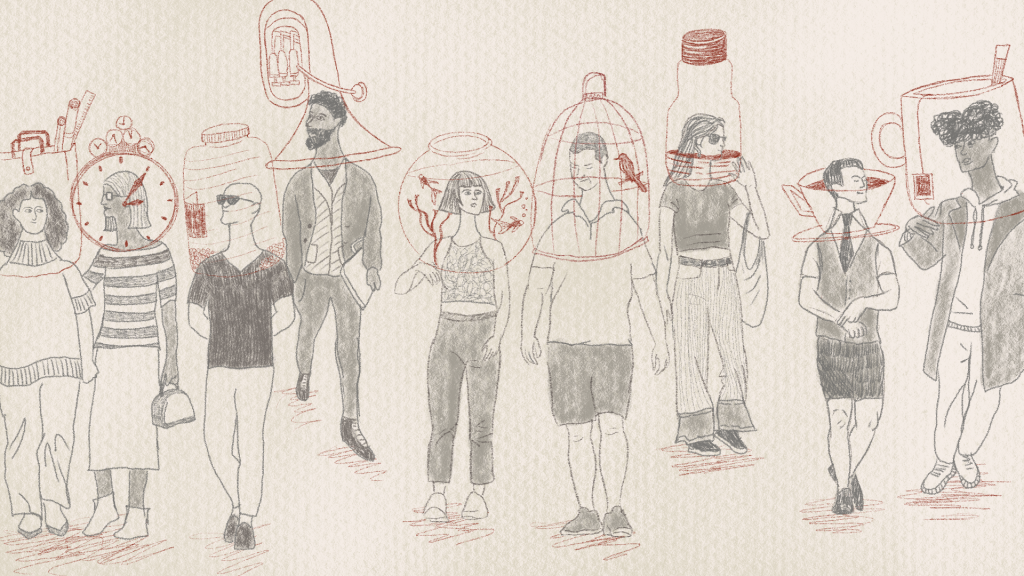Written by Malena Sanchez Moccero
Medically reviewed by Paula Alvarez (Psychologist, Dance-Movement Therapist, Emotional Intelligence Specialist & Applied Neuroscience in the Educational Field Specialist)
Art by Jouli Di Marco
As we enter our 40s, the landscape of our social connections often shifts dramatically. The effortless friendships of our youth may fade, and the bonds we once held close can become harder to maintain. While research highlights the importance of friendships for overall well-being, something changes at this stage in life. Whether due to external factors or internal shifts, many experts have studied and written about the crucial role these relationships play.
In the United States, friendship remains a fundamental part of life. A Pew Research Center survey found that 61% of adults consider close friendships essential for a fulfilling life—ranking them higher than marriage, parenthood, or financial success, which many people often prioritize instead. Yet, despite recognizing their importance, maintaining friendships in middle adulthood can be challenging. As we age, building and sustaining meaningful connections often requires more effort.
According to the Harvard Study of Adult Development—which has followed generations of individuals to understand the keys to a happy, fulfilling life—, the answer lies in maintaining strong relationships. Friendships, in particular, offer numerous psychological and emotional benefits. Science has consistently shown that these social connections contribute significantly to happiness and overall life satisfaction.
Friends will be friends, when you’re in need of love they give you care and attention. But if friendships are so valuable, why does making and keeping them after 40 seem so much harder? What are the barriers to building meaningful connections, and how can we rethink our approach to friendships at this stage in life?
I’ll Be There For You… Or Not
The reality is that forming deep connections becomes increasingly challenging after our 30s. According to Lydia Denworth, author of Friendship: The Evolution, Biology, and Extraordinary Power of Life’s Fundamental Bond, our 30s are “the decade where friendship goes to die.” While this may sound dramatic, evidence suggests that many people experience a significant reduction in close friendships during this period, with the trend continuing into their 40s.
A study from the National Library of Medicine, which analyzed the social lives of over 177,000 people, found that our social circles expand until around age 25, after which they begin to shrink. As life becomes more complex—with growing work responsibilities, family commitments, and personal health concerns—maintaining friendships can feel like a secondary priority.
Beyond external pressures, we also undergo internal shifts that impact how we approach relationships. Our priorities evolve, leading us to invest more time in personal growth, parenting, or career advancement. These changes may unintentionally create distance from old friends, while new friendships seem harder to form.
Journalist Anne Helen Peterson coined the term “The Friendship Dip” to describe this phenomenon—the period in midlife when maintaining close friendships becomes particularly difficult. Studies like Pew Research also highlight this decline, shedding light on why so many adults struggle to sustain meaningful social connections.
As life becomes more complex—with growing work responsibilities, family commitments, and personal health concerns—maintaining friendships can feel like a secondary priority.
Why Is It Harder to Make Friends After 40?
We can give a million reasons, but several factors contribute to the challenge of building friendships in midlife.
Firstly, our busy schedules leave little room for cultivating new relationships. Between work demands, family responsibilities, and self-care, social connections often take a backseat. In addition, shifting priorities like parenting or self-development, or even increasing individualism, reduce the time or energy to nurture friendships.
As we grow older, life experiences change the way we feel about relationships. We experience health issues, the loss of loved ones, or other major life events that can reshape how we see and value our social circles, sometimes even causing friendships to fade.
Generational differences imply that today’s 40-somethings experience social life differently from past generations. Decades ago, social gatherings were centered around community hubs—churches, sports clubs, neighborhood meetups, camping trips—where friendships formed naturally. Today’s adults find such opportunities rarer and often build their social lives around their children’s activities, making it harder to prioritize their own friendships.
As we grow older, We experience health issues, the loss of loved ones, or other major life events that can reshape how we see and value our social circles.
Strategies for Building and Maintaining Friendships in Your 40s
While making new friends in your 40s can seem daunting, there are ways to overcome these challenges. Friendships are not just about social benefits—they are crucial for emotional well-being, providing support during tough times, boosting happiness, and even improving physical health. However, keeping these bonds strong requires intentional effort. Here are some practical tips to help you build and maintain special and meaningful connections:
1. Strengthen Existing Relationships
Deepening existing connections with acquaintances—whether through work, your kids’ school, or shared hobbies—can lead to meaningful friendships. Not every friend needs to be a lifelong confidant; even casual connections contribute to well-being. Consider joining in-person meetups or groups related to your hobbies or interests. By making an effort to connect with the people already around you, you may discover strong, new friendships in unexpected places.
2. Be Open and Approachable
As we get older, we often care less about how others perceive us. While this can be liberating, it’s essential to balance this newfound confidence with attentiveness, and the ability to communicate effectively. Being a good listener and showing genuine interest in others fosters more honest, deeper bonds.
3. Don’t Assume Others Have Their Own Circles
It’s easy to assume that someone already has a full roster of established friendships and wouldn’t be interested in forming new ones. However, it’s important to challenge this belief. If you feel drawn to someone, reach out and let them decide if they want to invest in a new friendship.
4. Diversify Your Friendships
We sometimes limit our social connections to people in the same age group or life stage, but intergenerational friendships can be enriching. According to an AARP study, 37% of adults have a close friend at least 15 years older or younger. People most often meet these friends at work (26%), in their neighborhood (12%), at church (11%), or through mutual friends (10%). These friendships can offer fresh perspectives and deepen your sense of connection.
Friendships are crucial for emotional well-being, providing support during tough times, boosting happiness, and even improving physical health. However, keeping these bonds strong requires intentional effort.
5. Prioritize Social Time
With busy schedules, time is precious and socializing may seem like a luxury, but even small moments of connection can go a long way. Make a conscious effort to prioritize time with friends. Whether it’s a quick coffee meet-up, a weekly exercise class, or a simple phone call, maintaining regular contact is vital.
6. Join Group Activities and Volunteering Opportunities
If you’re struggling to meet new people, consider engaging in group activities or hobbies that align with your interests. Exercise classes, book clubs, or even volunteering can introduce you to like-minded individuals and provide a natural setting for building friendships.
7. Leverage Technology
While in-person meetups are often the most fulfilling, online platforms and apps can help you meet people with shared interests. Many digital communities foster real-world friendships, broadening your social network.
8. Set Aside Time for Friends Regularly
Whether through scheduled meetups, regular phone calls, or even group trips, making your friends a priority will help maintain strong and supportive relationships. Even if you don’t see each other frequently, knowing you have a support system makes a significant difference.
Prioritizing Friendships for a Fulfilling Life
As we navigate the complexities of life in our 40s, it’s easy to overlook the importance of friendships. But as numerous studies show, strong social connections are key to a long, happy life. It’s not about the number of friends you have—it’s about nurturing the relationships that truly matter.
In the end, friendships are about support, laughter, and growth. Even amidst the demands of adulthood, investing time in these connections brings joy, resilience, and a sense of belonging that enriches life in countless ways for the years to come.






